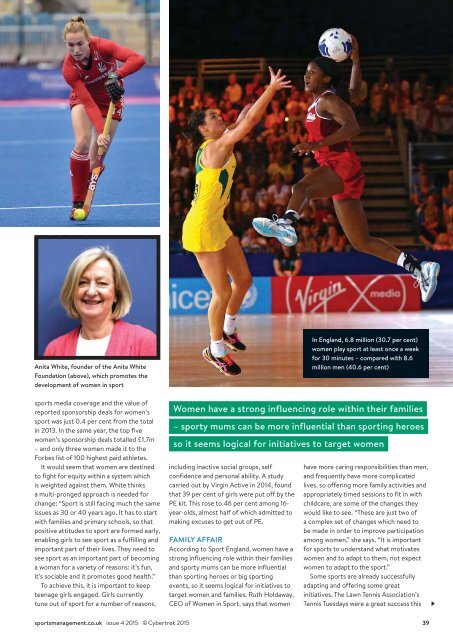EDDIE IZZARD
SM_issue4_2015
SM_issue4_2015
Create successful ePaper yourself
Turn your PDF publications into a flip-book with our unique Google optimized e-Paper software.
Anita White, founder of the Anita White<br />
Foundation (above), which promotes the<br />
development of women in sport<br />
sports media coverage and the value of<br />
reported sponsorship deals for women’s<br />
sport was just 0.4 per cent from the total<br />
in 2013. In the same year, the top five<br />
women’s sponsorship deals totalled £1.7m<br />
– and only three women made it to the<br />
Forbes list of 100 highest paid athletes.<br />
It would seem that women are destined<br />
to fight for equity within a system which<br />
is weighted against them. White thinks<br />
a multi-pronged approach is needed for<br />
change: “Sport is still facing much the same<br />
issues as 30 or 40 years ago. It has to start<br />
with families and primary schools, so that<br />
positive attitudes to sport are formed early,<br />
enabling girls to see sport as a fulfilling and<br />
important part of their lives. They need to<br />
see sport as an important part of becoming<br />
a woman for a variety of reasons: it’s fun,<br />
it’s sociable and it promotes good health.”<br />
To achieve this, it is important to keep<br />
teenage girls engaged. Girls currently<br />
tune out of sport for a number of reasons,<br />
including inactive social groups, self<br />
confidence and personal ability. A study<br />
carried out by Virgin Active in 2014, found<br />
that 39 per cent of girls were put off by the<br />
PE kit. This rose to 46 per cent among 16-<br />
year-olds, almost half of which admitted to<br />
making excuses to get out of PE.<br />
FAMILY AFFAIR<br />
According to Sport England, women have a<br />
strong influencing role within their families<br />
and sporty mums can be more influential<br />
than sporting heroes or big sporting<br />
events, so it seems logical for initiatives to<br />
target women and families. Ruth Holdaway,<br />
CEO of Women in Sport, says that women<br />
In England, 6.8 million (30.7 per cent)<br />
women play sport at least once a week<br />
for 30 minutes – compared with 8.6<br />
million men (40.6 per cent)<br />
Women have a strong influencing role within their families<br />
– sporty mums can be more influential than sporting heroes<br />
so it seems logical for initiatives to target women<br />
have more caring responsibilities than men,<br />
and frequently have more complicated<br />
lives, so offering more family activities and<br />
appropriately timed sessions to fit in with<br />
childcare, are some of the changes they<br />
would like to see. “These are just two of<br />
a complex set of changes which need to<br />
be made in order to improve participation<br />
among women,” she says. “It is important<br />
for sports to understand what motivates<br />
women and to adapt to them, not expect<br />
women to adapt to the sport.”<br />
Some sports are already successfully<br />
adapting and offering some great<br />
initiatives. The Lawn Tennis Association’s<br />
Tennis Tuesdays were a great success this<br />
sportsmanagement.co.uk issue 4 2015 © Cybertrek 2015 39


